Archive:Material deprivation and low work intensity statistics
- Data from January 2015. Most recent data: Further Eurostat information, Main tables and Database.
This article describes the non-monetary components of the social inclusion headline indicator ‘people at risk of poverty or social exclusion’ set out in the Europe 2020 Strategy: ‘people living in households with very low work intensity’ and ‘people severely materially deprived’. The monitoring of progress towards the EU2020 headline target, namely to reduce substantially the number of people at risk of poverty or social exclusion, will be based on past trends of the headline indicator number of people at risk of poverty or exclusion (AROPE), for the total population and for the main groups at risk at the European Union (EU) level. The non-monetary components of the headline indicator, which are material deprivation and work intensity, are primarily examined. These measures of poverty and social exclusion are analysed together with the monetary component (at-risk-of-poverty rate) in order to acquire a deeper understanding of poverty.
Main statistical findings
Material deprivation and severe material deprivation
Alongside income-related measures of poverty, a broader perspective of social inclusion can be obtained by studying other measures, for example, those relating to material deprivation. An analysis of material deprivation provides a more absolute rather than a relative analysis, as used for income poverty. The definition of material deprivation is based on the inability to afford a selection of items that are considered to be necessary or desirable, namely:
- having arrears on mortgage or rent payments, utility bills, hire purchase instalments or other loan payments;
- not being able to afford one week’s annual holiday away from home;
- not being able to afford a meal with meat, chicken, fish (or vegetarian equivalent) every second day;
- not being able to face unexpected financial expenses;
- not being able to buy a telephone (including mobile phone);
- not being able to buy a colour television;
- not being able to buy a washing machine;
- not being able to buy a car;
- not being able to afford heating to keep the house warm.
The material deprivation rate is defined as the proportion of persons who cannot afford to pay for at least three out of the nine items specified above, while those who are unable to afford four or more items are considered to be severely materially deprived.
About one in five people in the EU was materially deprived
Slightly less than two out of ten (19.5 %) members of the EU-28 population was materially deprived in 2013, with just half of these (9.6 % of the total population) being considered as experiencing severe material deprivation. The proportion of people that were materially deprived was highest in Bulgaria (58.0 %), Romania (45.8 %), Hungary (44.1 %) and Latvia (40.3 %) among the EU Member States, with more than half of the materially-deprived persons in each of these countries experiencing severe material deprivation. Similarly, in Lithuania, Greece and Italy, more than half of those considered as materially deprived experienced severe material deprivation. Less than one in ten people in Luxembourg, the Netherlands, the Nordic Member States and Austria were materially deprived (see Figure 1). The same was the case in Iceland, Norway and Switzerland.
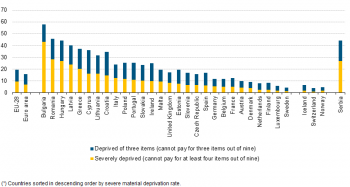
(%)
Source: Eurostat (ilc_sip8)
Focusing upon severe material deprivation (see Figure 2), in 2013 only 1.4 % of the population was severely deprived in Sweden, 1.8 % in Luxembourg and 3.8 % or less in the other Nordic countries and the Netherlands. Switzerland also had a very small percentage (1.0 %) of the population that were classified as being severely materially deprived. On the other hand, in Bulgaria, 43.0 % of the population were found to be severely materially deprived, while more than one in five persons in Romania (28.5 %), Hungary (26.8 %) and Latvia (24.0 %) fell within this category. Overall, at the EU-28 level and in the euro area, the severe material deprivation rate decreased by 0.3 percentage points (pp) between 2012 and 2013. The largest increase among the EU countries, was observed in Portugal (+ 2.3 pp) and the largest decrease in Lithuania (– 3.8 pp) and Italy (– 2.1 pp).
Factors of material deprivation rate
Inability to afford unexpected financial expenses, followed by inability to afford a meal with meat, chicken, fish or a vegetarian equivalent every second day showed the greatest variability between 2012 and 2013
Among the factors (‘items’) that are considered in determining the material deprivation rate, ‘facing unexpected expenses’ and ‘inability to afford a meal with meat, chicken, fish (or a vegetarian equivalent) every second day’ showed the greatest absolute difference at EU-28 level between 2012 and 2013.
In 2013, 39.7 % of the EU population reported difficulties in facing unexpected expenses, which represents a decrease of 0.6 pp compared with 2012 (see Figure 3).
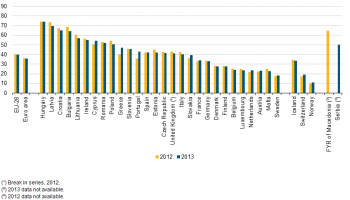
(%)
Source: Eurostat (ilc_mdes04)
Compared with 2012, the percentage of people reporting difficulties in facing unexpected expenses increased by 6.6 pp in Greece and 7.3 pp in Portugal. At the same time it fell by more than 3 pp only in Bulgaria (– 4.5 pp), Latvia (– 4.1 pp), Poland (– 3.6 pp) and Lithuania (– 3.5 pp).
There is considerable variation among EU Member States for both items. The percentage of people reporting difficulties to face unexpected expenses in 2013 was about 24.2 % or less in Belgium, Luxembourg, the Netherlands, Austria, Malta and Sweden as well as in Norway and Switzerland; while it was above 60.0 % in Bulgaria, Croatia and Latvia reaching a maximum of 74.2 % in Hungary.
Regarding the inability to afford a meal with meat, chicken or fish (or vegetarian equivalent) every second day, in 2013 10.6 % of the EU population reported that they could not afford this item. This represents a decrease of 0.3 pp compared with 2012 (see Figure 4). Changes in the deprivation item are in some cases correlated with the decrease in income in the lowest quintiles.
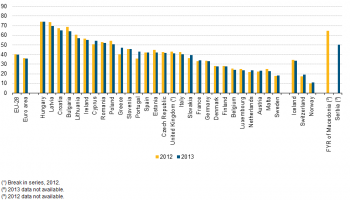
(%)
Source: Eurostat (ilc_mdes03)
The percentage of people reporting an inability to afford a meal with meat, chicken or fish (or vegetarian equivalent) ranged from 3.0 % or less in Denmark, the Netherlands, Norway, Sweden and Luxembourg to 22.1 % in Romania, 23.3 % in Latvia, 23.7 % in Slovakia, 33.0 % in Hungary and a maximum of 51.1 % in Bulgaria. Norway and Switzerland also had values lower than 3.0 %. Compared with 2012, the percentage of people reporting an inability to afford a meal with meat, chicken or fish (or vegetarian equivalent) every second day increased by 2.5 pp in Cyprus, 1.8 pp in Malta and 1.2 pp in Denmark. At the same time it fell by more than 2 pp only in Lithuania (– 4.0 pp), Croatia (– 2.7 pp) and Italy (– 2.6 pp).
Severe material deprivation by household type
Single-person households with dependent children are mostly classified as being severely materially-deprived
The rates of severe material deprivation are not uniformly distributed between the different household types. Table 1 shows how the rates of severe deprivation vary between different household types. Overall at the EU-28 level, the most severely materially-deprived persons lived in single-person households with dependent children (20.1 %) followed by single-male households (12.5 %) and households with two adults and three or more dependent children (11.4 %). On the other hand, persons living in households with elderly people (two adults, at least one aged 65 years or over) were overall the least affected (5.3 %) most probably due to the accumulation of durable goods during their working lives and more opportunities to save money. This was more or less the picture in most EU Member States, although there were some exceptions.

(% of specified population)
Source: Eurostat (ilc_mddd13)
In Bulgaria, Finland and Croatia, the percentage of the population that was found to be severely materially-deprived in single-person households was similar to the percentage of those found in single-person households with dependent children while in Hungary and Italy the percentage of severely materially-deprived persons living in single-person households with dependent children was similar to the percentage of those living in households with two adults and three or more dependent children. In the United Kingdom, Romania, Hungary, Latvia and Greece single-parent households were more affected by severe material deprivation than any other type of household. In Bulgaria, Croatia, Latvia, Lithuania and Romania, households with two adults and one dependent child were less affected by severe material deprivation than the households with elderly people. In Bulgaria, Romania and Hungary, the most affected households were those with two adults with three or more dependent children, while in Croatia the most affected were single males.
Severe material deprivation rate by citizenship
Foreign citizens mostly affected by severe material deprivation
Severe material deprivation affects foreign citizens to a greater extent than the citizens of the declaring country (see Figure 5). This is evident in the majority of EU Member States. The only exceptions are Malta (– 4.9 pp) and Hungary (– 1.2 pp) where deprivation rates for foreign citizens were reported to be lower than the respective rates for the citizens of the declaring country. On average, at the EU-28 level, severe deprivation rates were 5.8 pp higher in the foreign citizens’ population (14.7 % compared to 8.9 % for citizens of the reporting country). This rate has actually increased between 2012 and 2013 for foreign citizens (from 12.5 % in 2012 to 14.7 % in 2013) and decreased for citizens of the declaring country (from 9.2 % in 2012 to 8.9 % in 2013). The largest difference between foreigners and citizens of the declaring country in 2013 was reported by Greece (35.9 pp) followed by Portugal (18.7 pp), Slovenia (15.2 pp) and Belgium (14.5 pp).
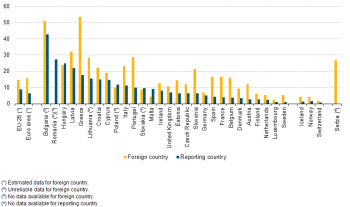
(%)
Source: Eurostat (ilc_mddd15)
Low work intensity
Work intensity is the ratio between the number of months that household members of working age (person aged 18–59 years, with the exclusion of dependent children aged 18–24) worked during the income reference year and the total number of months that could theoretically have been worked by the same household members. For persons who declared that they worked part-time, the number of months worked in full-time equivalent roles is estimated on the basis of the number of hours usually worked at the time of the interview.
People living in households with very low work intensity are defined as people of all ages (0–59) living in households where the members of working age worked less than 20.0 % of their total potential during the previous 12 months.
Following this definition, the proportion of people living in households with very low work intensity (see Figure 6) remained almost stable in 2013 as compared to 2012 and accounted for about 10.7 % of the population. However, this rate varied between EU Member States. On the one hand, less than 7.0 % of the target population was living in households with very low work intensity in Romania, Luxembourg, and the Czech Republic. In Norway, Iceland and Switzerland, rates were also relatively low (6.4 %, 6.2 % and 4.1 % respectively). On the other hand, the indicator exceeded 12.0 % in Portugal, Hungary, Denmark, Bulgaria, the United Kingdom, Belgium, Croatia, Spain, Greece and Ireland.
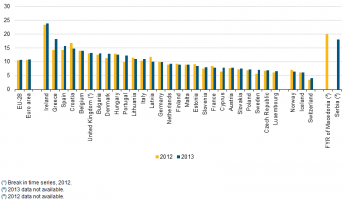
(%)
Source: Eurostat (tipslc40)
The indicator was relatively stable at the EU level. However, some variations were observed as it rose by more than 2 pp in Greece and Portugal (+ 4.0 and + 2.1 pp respectively) and decreased by more than 1 pp in Croatia, Latvia and Romania (– 2.0, – 1.7 and – 1.0 pp respectively). Switzerland also reported a relatively large increase (+ 0.6 pp).
Very low work intensity (see Table 2), for people aged less than 60, was most common in single-person households with dependent children and in single-person households (28.8 % and 23.4 % respectively at EU level) while it was the least common in households of two adults with one dependent child and households of two adults with three or more dependent children (6.1 % and 8.4 % children respectively at EU level). This was the overall pattern in the majority of countries.
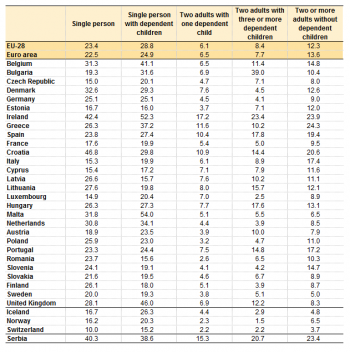
(% of specified population)
Source: Eurostat (ilc_lvhl13)
Some exceptions to this pattern were recorded in Lithuania, Finland, Romania Latvia and Croatia where the rates of single-person households were greater by more than 7.5 pp than those of single-person households with dependent children. In Belgium, Ireland, Greece, Malta and the United Kingdom on the other hand, very low work intensity rates for single-person households with dependent children were at least 7.5 pp higher than the rates for single-person households. Furthermore, Bulgaria was the only country where very low work intensity was the highest (39.0 %) among households of two adults with three or more dependent children rather than among single-person households with or without dependent children.
At risk of poverty or social exclusion
‘Severe material deprivation’ and ‘very low work intensity’ are two out of the three components of the Europe 2020 Poverty and Social exclusion indicator. The third component is ‘at-risk-of-poverty’, and represents the monetary element of poverty and social exclusion. In 2013, there were 47.0 million people in the EU-28 living in households that faced income poverty (but neither severe material deprivation, nor very low work intensity), 21.7 million persons experiencing severe material deprivation (but neither of the other two risks) and 14.0 million people living in households with very low work intensity (but facing neither of the other two risks). People are considered to be at risk of poverty or social exclusion if they face at least one of the three risks — although 36.4 million of those at risk of poverty or social exclusion within the EU-28 faced a combination of two or even all three of these risks (see Figure 7). In addition, 27.1 million people lived in households facing two out of three of these risks, while a further 9.3 million people lived in households where all three of these risks were present. In 2013, 377.9 million people faced none of the above-mentioned risks, as opposed to 377.4 million in 2012.

(million)
Source: Eurostat (ilc_pees01)
The evolution of poverty and social exclusion in 2012–13
In 2013, there were 122.6 million people in the EU-28, equivalent to 24.5 % of the entire population, who lived in households facing poverty or social exclusion (see Figures 7 and 8). This is a decrease of 0.3 pp (equivalent to approximately 1.5 million people) compared to 2012.
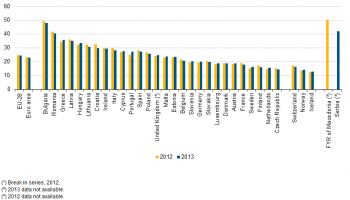
(%)
Source: Eurostat (ilc_peps01)
The latest developments between 2012 and 2013 show that the proportion of the population at risk of poverty or social exclusion fell by more than 1 pp in Croatia, Lithuania, Italy, Romania, Bulgaria, Finland, Latvia and France. The largest increases occurred in Portugal (2.1 pp), Greece and Hungary (1.1 pp each).
In absolute terms, the figures for the United Kingdom and Germany and to a lesser extent Portugal, Greece and the Netherlands had the greatest upward impact on the number of persons considered to be at risk of poverty or social exclusion in the EU-28 in 2013 compared with 2012. In particular, the United Kingdom and Germany reported an increase of 487 000 and 303 000 respectively in the number of persons at risk of poverty or social exclusion between 2012 and 2013, followed by Portugal, Greece, and the Netherlands (increases of 210 000, 110 000 and 156 000 respectively).
Data sources and availability
The data used in this section are primarily derived from microdata from EU statistics on income and living conditions (EU-SILC). The reference population is all private households and their current members residing in the territory of the Member State at the time of data collection; persons living in collective households and in institutions are generally excluded from the target population. The EU-28 aggregate is a population-weighted average of individual national figures.
Context
At the European Council held on 17 June 2010, the Member states’ Heads of State and Government endorsed a new EU strategy for jobs and smart, sustainable and inclusive growth, known as the Europe 2020 strategy. The strategy will help Europe to recover from the crisis and come out stronger, both internally and at the international level, by boosting competitiveness, productivity, growth potential, social cohesion and economic convergence.
The poverty issue is a milestone in the Europe 2020 strategy. One of the headline targets is "Reduction of poverty by aiming to lift at least 20 million people out of the risk of poverty or social exclusion" and "European platform against poverty" is one of the seven flagship initiatives. The eradication of poverty also remains a major challenge of sustainable development, and the social dimension is one of the pillars of the EU’s Sustainable Development Strategy (EU SDS).
This article describes two of the three components of the social inclusion headline indicator "People at risk of poverty or social exclusion" set out in the Europe 2020 Strategy. It also provides an overview of the composition of the headline indicators.
See also
- Employment statistics
- Children at risk of poverty or social exclusion
- Income distribution statistics
- Over-indebtedness and financial exclusion statistics
- People at risk of poverty or social exclusion
- Social inclusion statistics
Further Eurostat information
Publication
- Living conditions in Europe — 2014 Edition — Statistical books
- 23 % of EU citizens were at risk of poverty or social exclusion in 2010 — Statistics in Focus 9/2012
- Combating poverty and social exclusion. A statistical portrait of the European Union 2010 — Statistical books
- Children were the age group at the highest risk of poverty or social exclusion in 2011 — Statistics in Focus 4/2013
- European social statistics (2013) — Statistical books
- Income and living conditions in Europe (2010) — Statistical books
- Living conditions in Europe (2002–2005) — Statistical pocketbooks
- Living standards falling in most Member States — Statistics in Focus 8/2013
- The Social Situation in the European Union 2009 — Statistical books
Main tables
- People at risk of poverty or social exclusion (Europe 2020 strategy) (t_ilc_pe)
- Living conditions (t_ilc_lv)
- Material deprivation (t_ilc_md)
Database
- People at risk of poverty or social exclusion (Europe 2020 strategy) (ilc_pe)
- Main indicator - Europe 2020 target on poverty and social exclusion (ilc_peps)
- Intersections between sub-populations of Europe 2020 indicators on poverty and social exclusion (ilc_pees)
- Living conditions (ilc_lv)
- Health and labour conditions (ilc_lvhl)
- Material deprivation (ilc_md)
- Material deprivation by dimension (ilc_mddd)
- Economic strain (ilc_mdes)
- People at risk of poverty or social exclusion (Europe 2020 strategy) (ilc_pe)
Dedicated section
Methodology / Metadata
- Income and living conditions (ESMS metadata file — ilc_esms)
- What can be learned from deprivation indicators in Europe?
- Measuring material deprivation in the EU
Source data for tables and figures (MS Excel)
Other information
- Regulation 1177/2003 of 16 June 2003 concerning Community statistics on income and living conditions (EU-SILC)
- Regulation 1553/2005 of 7 September 2005 amending Regulation 1177/2003 concerning Community statistics on income and living conditions (EU-SILC)
- Regulation 1791/2006 of 20 November 2006 adapting certain Regulations and Decisions in the fields of ... statistics, ..., by reason of the accession of Bulgaria and Romania
